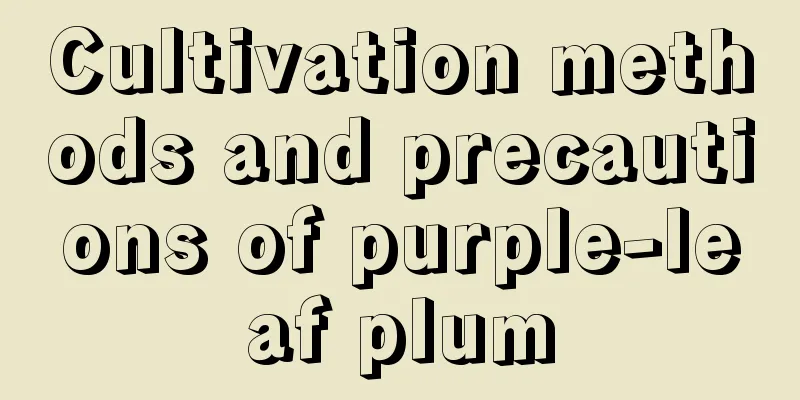Cultivation methods and precautions of purple-leaf plum

Cultivation method of purple leaf plumTemperature and lightPurple-leaf plum likes warm and humid climate, is not cold-resistant, and likes sunlight. It should be planted in a sunny place and should never be planted in the shade or under a big tree. soilPurple-leaf plum grows well in fertile, deep, well-drained, clay, neutral, and acidic soils. Generally, gravel soil is preferred, but clay soil is also acceptable. Watering and fertilizingPurple-leaf plum likes a moist growing environment and needs to be watered sufficiently during the growing period. Due to the heavy rainfall in July and August, you don't need to water the plants, and you still need to do a good job of drainage to prevent water accumulation and root rot. After entering autumn, watering must be controlled, otherwise excessive water will cause the branches to grow too long, which will easily cause frost damage in winter. Purple-leaf plum likes fertilizer. Before watering the plant every year, you can apply some farmyard manure to promote the vigorous growth of the plant. However, although purple-leaf plum has the characteristic of liking fertilizer, it only needs to be fertilized once in late autumn every year. Because if fertilizer is applied too many times or in too large an amount, the color of the leaves will easily become darker and not bright, reducing its ornamental value. Reproduction methodGenerally, three methods are used: cutting propagation, bud grafting, and aerial layering. Things to note when growing purple-leaf plumPruning workThe best tree shape for purple-leaf plum is the "sparse layered shape", and the "natural open heart shape" can also be adopted. When pruning the main branches at each layer, some side branches should be retained appropriately to make the crown fuller but not hollow. After the tree shape is basically formed, it only needs appropriate pruning every year, such as cutting off dense, drooping, overlapping and dead branches. Pest controlThe main pests are spider mites, spiny moths and bagworms The most common disease is bacterial perforation, which is widespread and serious. Once it occurs, it affects the normal growth and ornamental value of the plant and may even cause death. |
<<: Maintenance methods of lily of the valley flowering in winter
>>: When does the leek lotus bloom?
Recommend
How much does it cost to build a vegetable shed per acre (how much does it cost to build a vegetable shed per acre)
Today's steel frame vegetable greenhouses use...
How to grow the succulent Huangli and make it change color quickly
Main causes of discoloration This plant loves war...
When is the best time to repot the photinia? In which month is it suitable to repot?
Time to repot the photinia The Chinese photinia n...
How to grow potted figs
Growth environment The root system of figs is rel...
When does the viburnum bloom?
When does it bloom? When is the flowering period ...
What fertilizer does green radish need?
1. Required elements There are two main elements ...
What to do after the lotus blooms
1. Specific period The flowering period of this p...
When and how to plant peas
1. Time Planting should be done at the right time...
How to prune peacock ball
1. Withered and yellow leaves There are also smal...
The difference between Calla Lily and Dripping Guanyin
1. Calla Lily It belongs to the Araceae family an...
How to grow sweet potatoes
1. Maintenance methods 1. Temperature: Sweet pota...
When is the best time to plant longan?
China has abundant fruit resources. In addition t...
How to grow geranium in summer
7 elements of geranium summer care 1. If you plan...
How to divide the Avalokitesvara yinensis
Why is it suitable for division? We all know that...
How to prune roses
1. Winter pruning It needs to be pruned at the be...









